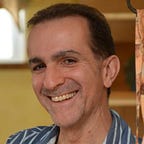So it goes again
Kurt Vonnegut: Unstuck in Time — a brief review
“What are people for?”
It’s a question that the late great writer Kurt Vonnegut once wrote on a card to his friend, filmmaker Robert B. Weide, that appears near the end of the documentary Kurt Vonnegut: Unstuck in Time. It’s a simple, yet profound question that, like so much of what’s revealed in this great work, stays with you long after the credits roll.
A documentary that’s some 40 years in the making, Unstuck in Time is a work of art that’s worthy of its subject — which is to stay, it’s great. It works on two levels — as a tribute to Vonnegut and testament to a great friendship between the two men. That’s why Weide took the unfamiliar and uncomfortable spot of sitting on the other side of the camera in parts and having his story become part of his subject’s story.
It’s all there in this film: Vonnegut’s brilliance and wit, his infectiously boyish humour captured in audio and video, his manic moody episodes, the triumphs and tragedies of his life. We learn some things about our hero that reveal he had feet of clay, perhaps details we wish we hadn’t known. For instance, how Vonnegut sometimes treated his children and first wife.
But then, that’s what makes Vonnegut human. Human enough to once quip,
“The truth is, we know so little about life, we don’t really know what the good news and what the bad news is. And if I die — God forbid — I would like to go to heaven and ask somebody in charge up there, ‘Hey, what was the good news and what was the bad news?’”
Vonnegut’s books were weird — and weirdly popular. They remained so throughout his long life and beyond imitating the famous line he made popular in Slaughterhouse-Five, “So it goes.” He described his work as “aggressively unreal. They make the reader accept the premise, an unreasonable premise, and then keep going.”
The great writer also reveals a philosophy in his writing in one scene, in which he remembers the death of his dear sister Allie: “The way to achieve artistic wholeness is to create with one person in mind,” he said.
The documentary also includes the sort of literary afterlife of Vonnegut as a popular public speaker, especially in delivering commencement addresses. A kind of 20th century Mark Twain, both in his humorous and profound writing and presence on the stage, Vonnegut regaled his audiences and left them and us with a treasure trove of wit and wisdom.
For instance, there was this piece of advice:
“The two experiences that will try you most are loneliness and boredom. We are all so lonesome, so much of the time, because we are meant to live in extended families, to have dozens or even hundreds of relatives nearby. Do what you can to have get yourselves extended families no matter how arbitrary they may be. We all need more people in our lives and they do not have to be high grade people either. They can be imbeciles because what matters is numbers. Good Lord, I certainly wish you well.”
From another speech:
“We are here on earth to fart around, and don’t let anybody tell you different.”
And this:
“If you really want to hurt your parents and don’t have the nerve to become a homosexual, the least you can do is go into the arts.”
Unstuck in Time, for those of us trapped in the amber of the moment (to use a memorable Vonnegut line) and fortunate enough to witness this great documentary, friendship and life of a great writer, has plenty more to entertain and enlighten us. They include interesting trivia about Vonnegut’s life, such as how members in his family’s hardware store invented the panic push bar on exit doors or how he was one of the first Saab auto dealers in the U.S.
Of course, there is also much about his art too. But I found that, like that simple question Vonnegut posed to Weide, it’s the little gestures and thoughts about the writer that stayed with me.
Such as these lines that he told one audience he would want read at his funeral:
“I have finished my course. I have ceased to enjoy and suffer. Please transfer your love and benevolence to your living fellowmen. The memory of the one as well as of the other is appreciated and honoured.”
And this:
“If things are going sweetly and peacefully, please pause a moment and then say out loud, ‘If this isn’t nice what is?’”
Or this simple signoff in a note he sent to his friend. It revealed, to me, the humanity and love that was inside the man.
It read simply: “Be happy, Kurt.”
Claudio D’Andrea has been writing and editing for newspapers, magazines and online publications for more than 30 years. You can read his stuff on LinkedIn and Medium.com and follow him on Twitter.
